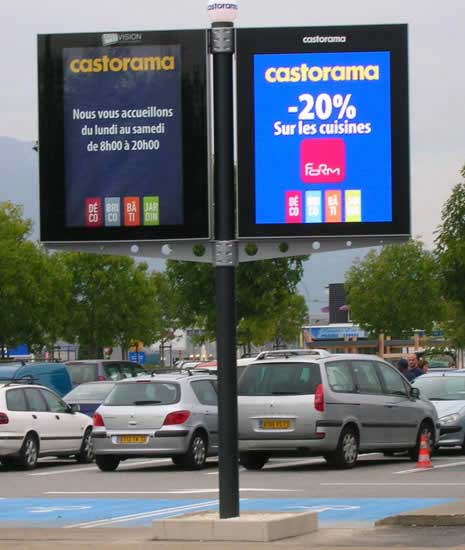Digital Displays
for Advertising and DooH
The popularity of digital-out-of-home (DOOH) advertising is skyrocketing as an effective marketing tool. Advertisers and brand owners worldwide are embracing DOOH, thanks to advanced digital technologies and innovative screen solutions. DOOH harnesses the power of digital displays and LED billboards to actively engage and captivate audiences in public spaces.
Its rise in popularity stems from its ability to deliver targeted, immersive, and contextually relevant content to a wide range of viewers. As a result, more and more advertisers and brand owners are realizing the tremendous potential of DOOH in real-time consumer reach and influence, brand awareness, and achieving their marketing goals.
Let’s consider what’s behind this trend
Print magazine and newspaper ad sales are going down, and it doesn’t look like they’ll recover soon. Most of their lost money is moving to digital ads, like online and digital-out-of-home (DOOH) ads. TV ad sales are also dropping because fewer people are watching TV. More people are watching streaming services like Netflix and Amazon instead.
In 2015, US digital-out-of-home ad revenue was almost $3 billion, which was about 41% of all outdoor ad spending. We think this will go up to 53%, or $4 billion, by 2018.
The increase in DOOH ad money is causing more digital screens to be sold. That’s why you’re seeing more screens in places like airports, subway and train stations, malls, convention centers, government offices, and libraries.
There are a few reasons for this growth:
- The cost of LED panels for outdoor billboards is getting cheaper, making them a good choice. Many traditional billboards and posters are still printed, but more are switching to LED, so there’s a lot of room for more digital screens.
- LED panels now have different pixel densities. More pixels mean clearer pictures, which are great for indoor screens. Fewer pixels are okay for big outdoor billboards.
- It’s easier to connect media players to the internet with more Wi-Fi and 4G data available. Now, displays just need a power source.
Digital displays also have many features:
- Thin edges make it easier to put multiple screens together.
- They come in many sizes, including special sizes for different needs.
- Smart displays with built-in technology don’t need extra players.

The advantages of digital screen advertising
Digital screen advertising offers significant advantages over traditional print-based advertising, and these advantages have been proven in many independent studies.
- Digital screen ads attract attention and have a significantly higher rate of recall compared to print media.
- Viewers dedicate more time to looking at digital displays than printed signs, underscoring the importance of maintaining fresh and captivating content.
- Ads delivered on digital advertising displays generate a greater number of impressions compared to print ads.
- While print ads experience a rapid decline in impressions after the first day, digital displays consistently generate impressions over a longer period.
- Digital advertising displays excel in capturing attention due to their distinctiveness when compared to print ads. Utilizing videos or animations on displays is particularly effective in seizing viewers’ attention.
- Digital displays for advertising excel in promoting impulse purchases, surpassing traditional advertising methods. Their higher recall rate contributes to their overall effectiveness.
- Digital advertising displays yield a significant increase in sales lift compared to traditional point-of-purchase methods.
How to get optimal results
Investing in digital advertising displays is a wise choice, but creating well-crafted ads is essential for achieving desired results. Always prioritize good content and regularly rotate the content to avoid falling short of expectations.
When selecting a venue for displaying ads, avoid simply reusing old TV ads for digital-out-of-home campaigns. Fifteen and thirty-second clips won’t be effective in busy areas. It’s crucial to adapt or create original content tailored for optimal outcomes. Avoid content longer than seven seconds in high-traffic areas. Instead, consider using short animations or static content and frequently change the message. This strategy increases impressions and improves retention.
Conversely, in places where people spend more time, like a doctor’s waiting room or a motor vehicle office queue, 15-second clips can be more effective than shorter ones. Viewers in these locations have more time to absorb the content. In such cases, having fewer impressions is acceptable and even preferred.

Targeted ads
Digital advertising displays have one huge advantage over traditional print advertising. They let advertisers adapt and tweak their message for specific viewers on the fly. Ad campaigns can be optimized based on a range of parameters such as location, time, event type, demographics (sex, age, etc.), and more. Results are analyzed over time and messages are revised as necessary, all at very little cost.
Using DOOH programmatic as an option automates buying and selling of digital out-of-home advertising inventory through real-time bidding platforms.
There are no shipping and handling charges every time you change your ad. With digital displays, it’s basically point-and-click. Changes in strategy can be implemented in real-time via your digital signage software which is much more efficient than with traditional methods. Mistakes can be corrected instantly. Different versions of the same ad can be tested in different markets, and the results analyzed to improve future campaigns.
Automated advertising delivery
Many companies have developed technologies that actively screen targeted ads on demand. Digital displays with video cameras and sensors can activate specific content based on the viewer’s characteristics. Advertisers can set detailed parameters like age and gender to ensure ads reach the right audience. Special software manages these advertising systems. These camera-based systems only gather visual information and don’t store video footage to protect privacy. The cameras act as sensors, recording and providing data on audience interactions to advertisers for analysis. This data reveals who viewed the screen and how long they engaged with it.
Ads can also be triggered using RFID, proximity sensors, beacons, and smartphone apps. The concept remains the same: detect interactions and screen relevant content. Stores using RFID tags to track products can show unique ads when a shopper with a matching item approaches the display. For example, if someone holding pants walks by a digital display, it can activate an ad for socks. This targeted advertising captures viewers’ attention and provides valuable information. Stores running these campaigns track ad impressions and match the data with sales information to evaluate each ad’s performance. They can edit or replace ads that fail to generate enough interest.
Digital signage displays that actively engage with the audience have higher retention rates compared to other media, including online ads. This is because the information is readily available when decisions are made.
Audience measurements
Digital out-of-home (DOOH) audience measurement offers produces metrics on advertising effectiveness. By providing real-time data on footfall and vehicle counting, behavior, and engagement metrics, DOOH audience measurement enables advertisers to tailor their campaigns more precisely to target audiences. This leads to improved campaign performance and higher ROI as advertisers can allocate resources more efficiently based on audience insights.
Additionally, audience measurement facilitates accountability and transparency in the DOOH advertising ecosystem, fostering trust and confidence among advertisers and stakeholders.
Recommended hardware for your digital display system
A digital display for advertising comprises a screen LCD or LED powered by an Android media player displaying ads. Navori markets Stix, a media player device delivering big performance.
The alternatives include using System-on-Chip (SoC) displays with integrated media players for LCD screens or a Windows PC for LED screens. Navori offers its app player for all hardware solutions available on the market.

 Copy link
Copy link